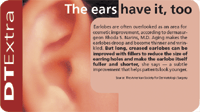- General Dermatology
- Eczema
- Chronic Hand Eczema
- Alopecia
- Aesthetics
- Vitiligo
- COVID-19
- Actinic Keratosis
- Precision Medicine and Biologics
- Rare Disease
- Wound Care
- Rosacea
- Psoriasis
- Psoriatic Arthritis
- Atopic Dermatitis
- Melasma
- NP and PA
- Skin Cancer
- Hidradenitis Suppurativa
- Drug Watch
- Pigmentary Disorders
- Acne
- Pediatric Dermatology
- Practice Management
- Prurigo Nodularis
Article
Patient education crucial for non-invasive lifting tx
Chicago - The latest trend in facial rejuvenation is the move toward non-invasive tissue-tightening techniques.
Chicago - The latest trend in facial rejuvenation is the move toward non-invasive tissue-tightening techniques.
Do they work?
Brian D. Zelickson, M.D., of Minneapolis, outlined some of the challenges facing doctors who want to offer the treatments - most of which are still relatively new to public use.

No surgery substitute
He says the standard for assessing non-invasive skin tightening is the ThermaCool™ device made by Thermage.
"The ThermaCool device is a monopolar radiofrequency device with contact cooling which has been out the longest and has shown that it can perform the task. It does work."
Dr. Zelickson reminded those attending the summer meeting of the American Academy of Dermatology here, that no device is a replacement for surgical options, however.
He says, "They make a nice alternative for those who don't want to go through an invasive procedure or who don't need that kind of tightening."
Other devices now being used are the Titan by Cutera, which uses light therapy, and the Synernon Polaris - a laser and bipolar radiofrequency device.

Dr. Zelickson has all three devices in his practice. He says there are too few published studies evaluating the definitive tightening that results from these latter two devices, but he expects more to be done, and expects his practice to get involved, too.
Histologic changes
Dr. Zelickson says there is histology that shows changes do occur in the dermis with the newer devices. However, to date, the deeper changes detected in the fibrous septae of the fat has only been detected after the ThermaCool treatments.
"We published changes in collagen fibrils using electron microscopy," he says. "These changes are a partial to complete denaturation of some of the collagen fibrils within the dermis. That suggests you're getting some immediate tightening with the contraction of the collagen fibril."
Dr. Zelickson says additional changes can be seen - specifically with ThermaCool.
"The way that monopolar radiofrequency works is that the heat and electrons pass through the least-resistant tissue," he explains." So when that goes down to the fat, there is fibrous septae within the fat and the heat is funneled through those fibrous bands. They then contract so that there is more contouring - or tightening - in the vertical aspect, as opposed to the horizontal aspect of the tissue."
Dr. Zelickson thinks that may be why the ThermaCool treatment may prove to be somewhat more effective than the other two therapies.
"Light-based devices that perform bulk heating do not have that selectivity that we've been able to demonstrate with ThermaCool," Dr. Zelickson says.





